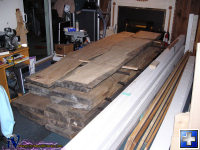My father in law and I picked up the maple this past rainy Saturday. We figure it weighed in at around 2500 pounds, a little over the rating on his truck. Nevertheless, we made the almost two hour trip back in the pouring rain with no problems.
The wood is currently in my basement (which is heated and open to the upstairs) acclimating. I will cut it into manageable pieces and begin the resawing process soon. Once I resaw it, it will go back in the house on stickers to finish acclimating. The moisture content right now is a bit higher than I would like it to be (9-11% taken at the ends, which are likely damper than the kiln-dried centers), as the wood had been in the warehouse for a while.
I put a little water (alcohol would have been better, but I had none handy) on one of the sawn boards to check out the figure. There are at least three boards that look like this; I suspect the majority of the rest are much less interesting, but useful nevertheless. We'll see once I belt sand the grime off in preparation for resawing and planing.


As you can see, the figure is pretty spectacular for wormy / ghost tiger maple. The color looks like it will be great as well, with a reddish tone that will really fit the decor. (The Durastick composite stickers were purchased from Grizzly. They are more for air/kiln drying, as they will not stain the wood. However, they work well here as well. You never want to stack wood face to face, without air space, as you'll get uneven drying which will lead to warps, twists, and potentiall face checks and splits.)
As a plus, several of the pieces are 2 1/2" thick. Other than the two thin pieces at the top (which are 6/4), the rest are all 9/4 or 10/4, making the total board foot for this stack right around 520 board feet, meaning it ran me only about $4 bd/ft. For a log run (all matched wood, from the same tree), that is a really good price. That being said, some of that will be lost to the planer and bandsaw, and of course, the difficult defects and wany edges will likely go (although some knots might look nice, if they have some character, and I may save a wany-edged slab or two for a coffee table top). I also plan to use both the heartwood and the sapwood, as we're really looking for something with significant character. I believe I can combine all three without the cabinets looking too busy - the rather plain craftsman-style will help there, as the wood will be the focus instead of ornamentation.
I'll need to figure out how to make the most of this wood in the frames, doors and drawers. The panels in the doors need not be full thickness, as my wife would prefer them to be flat (but I refuse to use plywood for the panels), so I can use 5/8" or 3/4" if I want, allowing me to make the most of the heavily figured boards. I'd prefer everything else to be a full 4/4 after planing.
Oh, I saw another name for this (and similar woods) on a forum recently: ambrosia maple. It looks like that name covers all sorts of spalting, however.
